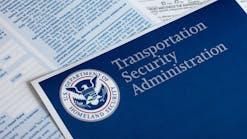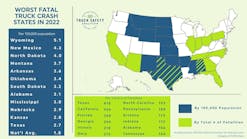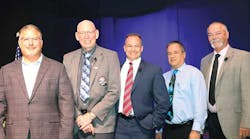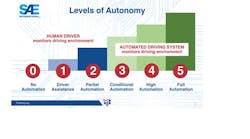ELD might as well stand for Everybody Loves Drama when it comes to the enforcement of the Electronic Logging Device mandate first published by the Federal Motor Carrier Safety Administration nearly three years ago.
Officers making roadside stops since the first ELD compliance deadline in December have seen it all — from drivers who can’t tell the difference between an AOBRD and an ELD, or can’t operate their ELD, to exaggerated personal conveyance and a lack of parking complicating Hours of Service (HOS) satisfaction.
“Our biggest issue with ELDs is that we’re still talking about ELDs,” said Paul Enos, CEO of the Nevada Trucking Association (NTA) during an enforcement update at the National Tank Truck Carriers Safety & Security Council 2018 Annual Meeting at the Eldorado Resort & Casino in Reno, Nevada.
Fortunately for drivers in Nevada, officers still are softly enforcing the law, but their patience is going to dry — just like the state’s heat.
“There are over 360 (ELD) devices out there — with 360 different programs — and for our officers to know more than 10 is tough,” said Lt. Roy Baughman, deputy commander and commercial coordinator for the Nevada Highway Patrol. “So the biggest thing I can say is, when you give someone an ELD, sit them down in a classroom, with an ELD and an instruction manual, and say, ‘This is how you operate it.’ Because the longer it takes us roadside, and the longer it takes the trooper to inspect the truck, the longer you guys are down. So, training’s been our No. 1 issue.”
ENT (Everybody Needs Training)
Baughman said his officers are seeing an “overabundance” of drivers who were assigned a truck with an ELD and told by management to “hit the road,” expecting them to train the drivers during a stop.
So, a lack of classroom training with ELDs clearly is a problem.
But Enos expects time to alleviate many issues, as drivers become more familiar with how the devices operate — whether the driver’s 18 or 85 — just like when grandpa finally learned to operate the VCR.
“Ultimately, we’re going to get to a point … where it becomes pretty ubiquitous,” Enos said. “I can hand my kid an Android, an iPhone, a Surface Pro or an iPad, and he’s still going to be able to navigate it.
“(But) I know we are going through some challenges right now.”
That’s why he’s asking officers for a little more patience while everyone figures out these newfangled machines.
“One of the things I have really focused on, in working with our law enforcement partners, is asking them to work with our drivers,” Enos said. “If the driver can’t figure it out, and it’s something easy, where a law enforcement officer can say, ‘OK, I can get you to the right screen here, I can show you how to do this,’ do it. The biggest citations we’ve had on Hours of Service have been what? They haven’t been substantive violations. It’s been form and manner. And to me the beautiful thing about ELDs is we’re hopefully going to see form-and-manner violations go away.”
ELD vs. AOBRD
Trucks with Automatic On-Board Recording Devices installed before December, 2017, are protected from ELD enforcement by the grandfather rule, giving operators until December, 2019 to replace them with ELDs.
But many companies and their drivers still can’t tell them apart.
The critical distinction, Baughman said, is whether or not the device is following FMCSA regulations.
A detailed comparison is available on the administration’s website, but basically, though both devices connect to a vehicle’s engine to record HOS, ELDs display more, less-editable information.
“For roadside enforcement, a lot of the devices look the same,” Baughman said. “Some of them even have the same log-on screens … and until we actually try to transfer (data, we don’t know what it is).”
That’s because AOBRD reporting is more old-fashioned, whereas ELDs connect to the FMCSA’s online database, called RODS (Record of Duty Status), which officers can download to their devices.
“With an AOBRD, you can email (data) or do a printout on it,” Baughman said. “But the e-RODS, which is the Federal Motor Carriers’ database for all electronic logging tracking, gives us the ability to actually see it on our computers.
“So, from an AOBRD to an ELD, there are still companies out there right now trying to sell you an ELD that’s actually an Automatic On-Board Recording Device that does not transfer to e-RODS. So we’ve had, within the last few months, companies saying ‘Yea, we just put it in two months ago,’ and it’s an AOBRD.
“Companies can’t even tell it’s an AOBRD because they’re being marketed wrong.”
That’s not PC
Research is the key to AOBRD vs. ELD differentiation, and planning is essential for the proper use of personal conveyance.
“The biggest thing on personal conveyance is planning by our companies and drivers,” Baughman said. “Plan for the weather, plan for the traffic conditions and plan for where your driver’s actually going to stop.
“If your driver’s running out of hours, he’s running up on his last 15 or 20 minutes of driving, we’re seeing drivers flick themselves into personal conveyance mode and drive another 100 miles to try to find themselves a spot. Is that illegal? Sure it is. Is it going to be tough to enforce roadside? Sure it is.”
Personal conveyance allows for some flexibility, Baughman acknowledged, affording drivers the time to hunker down for the night without affecting their HOS compliance, but it’s also easily abused.
“We’re already seeing guys saying ‘Hey, can I bobtail my truck home 500 miles?’ No,” Baughman said. “But it’s being logged as personal conveyance and it’s being allowed. Is it right? Well …
“But we are going to see more of these. With Canada, the rule is 75 kilometers unladen. It’s hard and fast. The United States is letting them run laden now, and as long as it’s not betterment for the company, it’s with no mileage restriction. FMCSA gave us guidance here in the last month to that affect, so it makes it tough for law enforcement roadside. All I can say is, it falls back to the company to plan for your drivers. If they’re on the road 10½ hours, make sure they’re looking for a place to stay.”
Paucity of parking
But where, exactly, is a driver supposed to park his or her tractor and attached 53-foot trailer, officer?
Good question.
Roadside rest areas are few and far between, especially in Nevada, where much of the available real estate is owned by the federal government and paving vast swaths of land in particulate-matter, non-attainment areas is exceedingly expensive, which is why NTA is working hard on a solution.
“We have a study that is going on, started in March — so if you guys are operating in the Silver State and have any input, we would love to hear about — identifying places to park,” Enos said. “It’s a half-million-dollar study to look at truck parking throughout the state. And while local laws, especially down in Clark County, are very restrictive for truck parking, we’ve had numerous meetings. I’ve been to Vegas, just this year, 16 times, and we’re not even through half the year, and half of those have been truck-parking meetings with local government officials, with RTC (Regional Transportation Commission of Southern Nevada), so they know there’s a problem.
“We had a meeting with County Commissioner Susan Braggard down in Clark County, who said ‘I am not going to let our law enforcement guys ticket truckers for parking in neighborhoods when we don’t have places for them to park.’ So, we are trying to work with them to identify where those places are.”
Until then, plan for time to find elusive parking, and use the personal conveyance rule appropriately. Because, eventually — and it’s already happening in other states — enforcement will harden.
“For the most part, we’re still giving a soft enforcement period, just because it’s such an evolving technology,” Baughman said. “Pretty much, if we can see the previous seven days, and the status of the current day, we’re telling officers to kick them loose — as long as everything checks out.”













